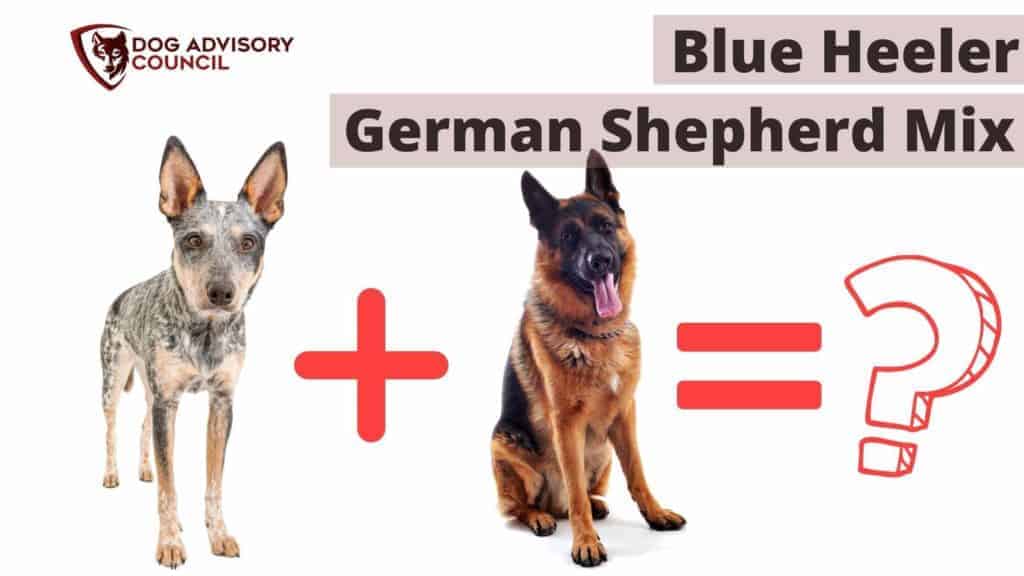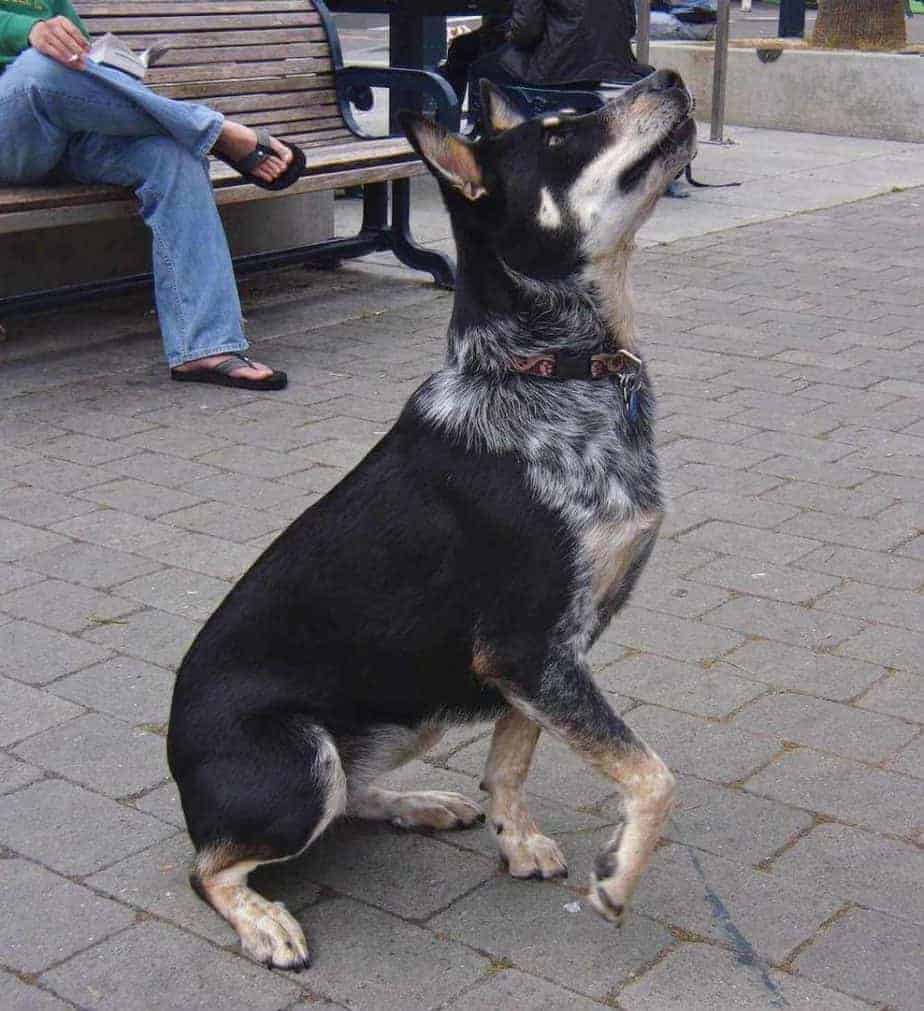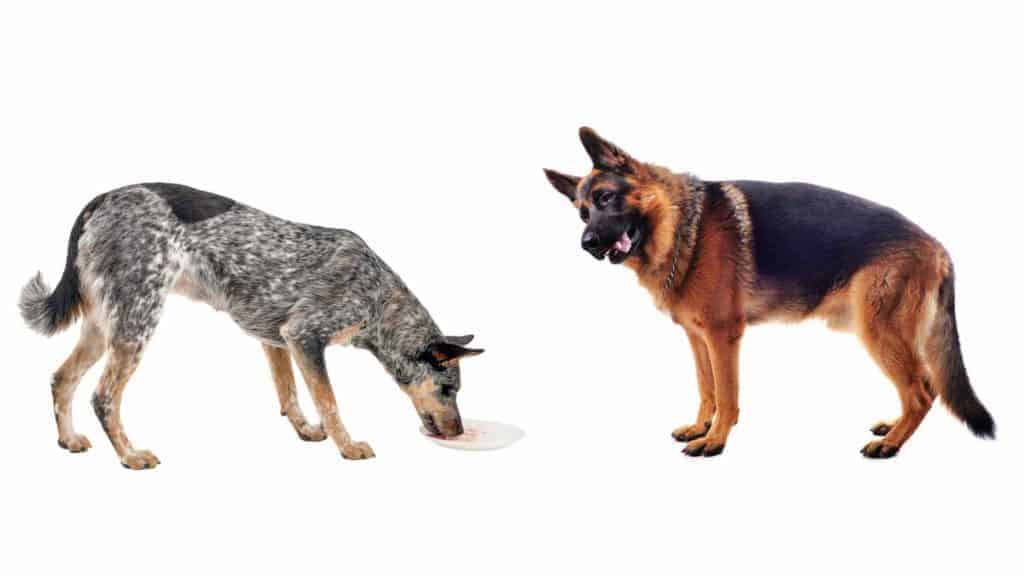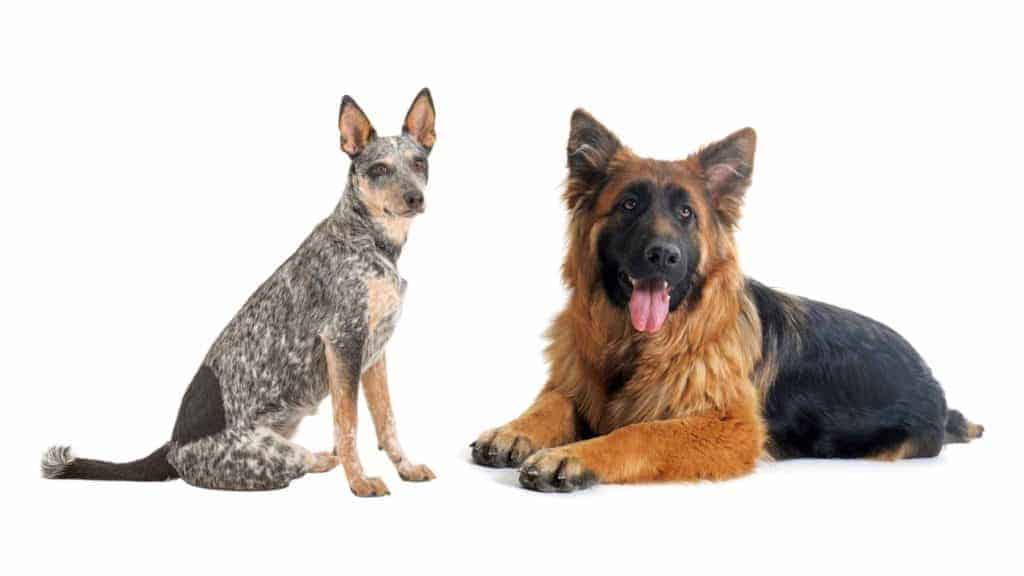
If you have a thing for designer dogs, one breed to know about is the Blue Heeler German Shepherd mix. Curious as to what makes this breed so special? Let’s take a look.
With a parent from each breed, a Blue Heeler or a Red Heeler, and German Shepherd mix is a medium to the large dog between 19-25 inches (48-63 cm) high and weighs between 40-80 pounds (18-36 kg).
These are really unique dogs as far as their combination of fur colors, and also have really different personalities compared to other mixed breeds. They’re also very new as a mixed breed, going back roughly only 30 years.
What is a Blue Heeler German Shepherd mix called?
There isn’t a consensus on names for this breed, given that they are considered rare and don’t have an easy-to-mash name!
Most just call them German Shepherd Heelers or Blue Heeler Shepherds. The most common name is still the full Blue Heeler German Shepherd mix (or Red, if that’s the Heeler parent)!
Blue Heeler vs. Red Heeler
If you’ve heard of a Red Heeler but not a Blue one, you aren’t alone! Both come from the same breed of cattle dog in Australia and share the exact same personalities and traits. The only difference is the actual hue of their fur.
Blue Heelers are cooler with greys and browns, whereas Red Heelers have warmed reds, browns, and maroon shades. Traditionally, Blue Heelers are mixed to form this designer breed, hence the name.
What does a Blue Heeler German Shepherd mix look like?
This is going to be the start of the fun for these unique and special dogs! They often don’t have the maks marking of the German Shepherd, but some do. For whatever reason, the mask part that does tend to come through is the eyebrows!
Most of these mixes will have some part of their coat that is speckled, which they get from their parent of the Blue Heeler. Some will have the speckling all over their bodies, and others will concentrate it in one part. The speckling can be really strong, but most will find it diluted in the coat’s base color.
Speaking of the base coat, your mix will have long glossy fur that is usually a bit wavy. Sometimes their fur can be shorter, thanks to their Heeler genes, but it’s more common in the longer GSD fur type! It will be smoother and glossier than the Shepherd’s natural fur, however. Common coat colors include:
- Brown
- Tan
- Black
- Grey
If you find a mix with Red Heeler used, you can expect to see more red in the browns and tans than the greys and whites.
Most tend to be solid in their base coat color, but you will get a two-toned option once in a while. Again, this is a fascinating mix breed that is relatively new, so there’s still a lot that experts are learning!

How big will a German Shepherd Blue Heeler mix get?
As mentioned above, you can expect your mix to reach between 19-25 inches (48-63 cm) high and weigh between 40-80 pounds (18-36 kg) as an adult. The Blue Heeler is quite a bit shorter than the German Shepherd, so you’ll see both the height and weight can vary quite a bit.
Often, you can get an estimate on the height from the parent breeds. In this case, however, that will vary as much as the range above does! Simply put, it can be hard to know just where on this scale your mixed puppy will be. Make sure you are prepared for either option!
What is the Blue Heeler German Shepherd Mix lifespan?
With a good blend of strong genes, you can expect your dog to live between 11-14 years as far as lifespan is concerned.
Unlike other mixed breeds, they don’t have too many health complications, other than just regular dog ones. There are a few to look out for, however, which we’ll talk about more below!
These dogs may not have a lot of severe health concerns, but you will need to be ready for the commitment of their temperament. This can be somewhat of a loose cannon, as we’ll get into next.
A Blue Heeler German Shepherd mix’s temperament
For those fascinated with dogs and the different ways that their genetics and attitudes can come out, this is a wonderful combination as far as all of those things. As far as the actual execution of those facets, it depends on what you’re looking for.
If we were to put the temperament of a Blue Heeler German Shepherd mix into one word, it would be this: energetic.
Both parent breeds were originally herders, so they spent their days running around and controlling sheep and other livestock. All this energy is then passed onto your mixed pup, who is getting it from both sides.
This means that your dog is going to need massive amounts of exercise to help with this. Quite often, it could be as much as 2 hours a day in combination with mentally stimulating toys. That’s a lot, even for the pet parent who’s used to having a high-energy dog.
Whether it’s physically or emotionally, these dogs are always going to be “on.” You’ll want to get used to always being ready to tend to those needs, even if you’ve just gotten back from a walk. For this reason, many do refer to them as being high-maintenance dogs!
As far as other features of their personalities, they do tend to be lovely and loyal. They are very protective and will put themselves at risk just to protect you. They fiercely love their humans and will always be on the lookout for danger.
They aren’t known for being cuddly, though. They prefer to nap away from other people and chaos so that they can keep an eye out for danger.

Are Blue Heeler German Shepherds good family dogs?
There is still some research in this particular part of the mixed breed. In general, these are good family dogs because they always like to be in the middle of things.
So high-energy it’ll rival a toddler on a sugar high, these are going to be an excellent choice for those families that just enjoy going everywhere. From camping trips to beach trips to a great hike in the mountains, these are going to be there for all of it — and then some.
As mentioned, they are very protective of their family. They can be reassuring when you want a dog that you know will stop an intruder. That being said, this protectiveness can mean that they will be a bit over the top when meeting new people or animals.
They will see everything as a threat, and it can be challenging to help them understand that a paper carrier is harmless. Socialization training and strict obedience training are serious must-dos with these dogs, but we’ll get into that a bit later.
Their protectiveness also comes in combination with a strong prey drive. Young children and other household pets can trigger that, which can mean attacks and lunges.
If you are set on bringing in a Blue Heeler German Shepherd mix. In that case, you’ll want to do it when your kids are older (say, 8 or 9 years old) and that they understand how to be “respectful” of this new furry addition.
Top Blue Heeler German Shepherd Mix health issues to know about
Since this mixed breed is still relatively unknown, the same goes for health issues!
The best advice right now is to think about and plan for common health issues of both parent breeds. These include:
- Dysplasia
- Allergies
- Cataracts
- Spinal issues
Dysplasia
In the hips or the elbows of their legs, large dogs like German Shepherds can have a problem where the joint and bone don’t connect properly.
This problem can lead to stiff movements, pain in the impacted joints, and even a loss in muscle mass. This often gets worse as the dog ages, much like arthritis!
Allergies
Allergies tend to be present in hives and other rashes on dogs. GSD can have allergies to certain ingredients in their food and treats. You’ll want to be watchful of any potential allergies in your dog since they can often be serious health concerns!
Your breeder will give you a complete history for both parents, so you can use that to gauge any potential allergies and then use that to talk to your vet.
Cataracts
A common problem with both breeds, especially as they age, the film of the eye starts to darken. This impacts vision either partially or entirely.
If you want to stop the progress, you will need to talk to your vet about surgery. Sometimes drops can help ward it off, but surgery is the only way to stop it entirely.
Spinal issues
Large dogs can have spinal issues. German Shepherds pass that on to this mix and make them susceptible to compressed vertebrae and degeneration, too.
It can lead to pain, difficulty moving, and even paralysis. Spinal issues are always serious and often are congenital. Your breeder should be checking for this before selling you puppies, of course.
How to take care of a Blue Heeler or Red Heeler German Shepherd mix
When you bring a vibrant Red or Blue Heeler German Shepherd mix into your family, you can expect to focus on a few issues when it comes to proper care of their needs:
- Exercise
- Mental stimulation
- Grooming
- Training and socialization
Exercise
As mentioned, this breed is going to be a high-energy one. You can expect 90 minutes to 2 hours of exercise every single day. You will want to split this up throughout the day for the best effect.
You can combine casual walks with fast-paced activities, like fetch. They must get this exercise to prevent anxiety and other issues (more on that next).
If you are a high-energy family, this will give you a true run for your money on who gets tired first! However, these are great companions for those that love to do something every single day!
Mental stimulation
Mental stimulation is essential for all dogs, but it’s crucial in this particular dog. Between their high energy level and their intelligence, these dogs always need to be moving and processing.
If they have nothing to do or process, they will turn to destruction. Even if you give your dog 2 hours of exercise but leave them on their own for 8+ hours with nothing to do, they will destroy your home.
This is not because they are angry or upset, but instead because they need something to occupy them! There are many options for mental stimulation that you can consider, including tug of war toys, puzzle mats, and doggy daycare. Or even something like a designated dog walker that can help take the pressure off their need to be “on.”
You will need to care for their mental needs as much as their physical ones, so make sure you think about this when arranging scheduling and toys.
Grooming
Both are coming from dogs with a heavy coat, and you’ll need to get used to brushing your dog about every 2 days. When the shedding is heavy twice a year, you will want to do it once ad ay!
Keeping their fur brushed is vital to prevent mats and help promote blood circulation and a strong connection between humans and dogs.
You don’t need to bathe them very often, but you will want to consider it every 3-4 months just to help keep their undercoat clean and their skin healthy.
The other main facet is going to be training and socialization. This is a strong-willed dog, thanks to their incredible and somewhat annoying intelligence.
Are they capable of understanding what to do? Yes. Will they listen to you? No, probably not.
You will need to have a strong personality and stubbornness of your own when training your dog. This is not a dog for those who are weak-willed because they will reign alpha, which will cause a problem for getting them under control!
Socialization is crucial so that they know not to immediately attack anyone that comes by. This includes pets, kids, and neighbors.
When you get them, immediately begin socialization training to become as much of a habit as it does for every other part of their care. You’ll want to consider both socialization and obedience classes for this strong-willed dog!

How much is a Blue Heeler German Shepherd mix?
The price for these dogs is going to start expensive and climb from there. A Blue Heeler German Shepherd Mix is going to be anywhere from $3 000 and up. A Red Heeler German Shepherd Mix, which is considered rarer by most, will be much more.
Regardless of the kind of Heeler you go with, make sure you do your research carefully on your chosen breeder. We can’t say this strongly enough.
These are complex dogs that, combined with a GSD, can be even more complex. It is a hard mixed breed to create successfully, and doing it wrong can lead to a harsh reality.
Namely, a dog that is so tightly wound that they can go neurotic even if you do everything in your power to go above and beyond in taking care of them. Or a dog that is extremely aggressive and a danger to those who love him most.
You’ll also want to choose a vet that has experience with both breeds, particularly the Heeler. They can often help you manage some of the wilder tendencies that can come out even in well-bred dogs.
Pros and cons of a Blue Heeler German Shepherd mix
There are some fantastic pros and considerable cons to this truly unique mixed breed. To help you make your decision with both eyes wide open, take a look below:
PROS
- Protective
- Great for high-energy families
For those families that want a dog that will go as long and longer as they will, this is it! They just love to be on the move and will do well with those families who feel the same.
They are best-matched for older kids and those who have someone home all the time to help dispel their anxiety and energy!
CONS
- Aggressive without training
- Needs an experienced owner
- Breeding is crucial to get right
Even in the best-case scenario, this is a dog prone to aggression. You will need to be comfortable with socialization and strict obedience training to help keep that aggression directed at people or animals where it is appropriate.
These are not dogs for new owners. You need to have had experience with intelligent, high-energy, and potentially aggressive dogs before. They will need a strong owner even in the best situation!
Finally
A new mixed dog breed, this features a parent that is either a Red or Blue Heeler and one that is a German Shepherd.
They’ll be 19-25 inches (48-63 cm) high and weigh between 40-80 pounds (18-36 kg).
They are high-energy, incredibly smart, and need an experienced and strong-willed owner for the best quality of life and everyone’s safety.
Not an easy choice unless you are committed to proper care of this high-energy dog. However, they have some wonderful attributes that will make them truly unique mixed breed dogs!
Blue or Red Heelers and German Shepherds make interesting dog breeds that will be excellent companions for just the right family. Know just the one? Share this with them!
